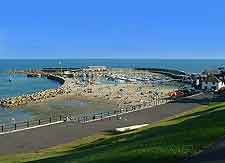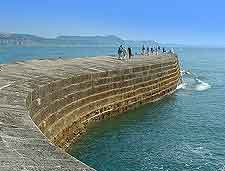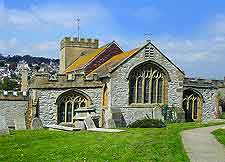Lyme Regis Landmarks and Monuments
(Lyme Regis, Dorset, England, UK)

Without question the principal landmark and attraction in Lyme Regis, the Cobb is especially famous, and rightly so. This curving harbour wall adds a great deal of character to the Lyme Regis seafront and provides much protection against the strong seasonal south-westerly gales.
Other prominent landmarks include St. Michael's Church, and also the Lyme Regis Town Mill - a fully restored working water mill, which remains in excellent order. The Town Mill is based around a cobblestone courtyard and stands next to the scenic River Lym.

The Cobb
Address: The Cobb, Lyme Regis, Dorset, England, UK
The Cobb was built in the 13th century and immediately brought much prosperity to the town, allowing Lyme Regis to grow into an important port and thriving centre for shipbuilding. However, in 1377 a major storm caused the destruction of the Cobb and as a result, around 50 boats and almost 100 houses were badly damaged and destroyed. The Cobb was rebuilt soon after and the town enjoyed tremendous prosperity between the 16th and 18th centuries, when boats arrived here from the Americas, Mediterranean ports and the West Indies.
At the end of the 17th century, the addition of the southerly arm provided further shelter, although it needed to be rebuilt just over 100 later. In the mid-18th century, the Lyme Regis Cobb was connected to the land, and in 1820, completely reconstructed in its present state using local Portland stone. Over the years, the Cobb has achieved further fame by appearing in a Jane Austen novel and the 1981 movie. The French Lieutenant's Woman by John Fowles (screenplay by Harold Pinter) saw the arrival of Hollywood movie star Meryl Streep, who was filmed walking on the Cobb and looking sadly out to sea. Today, the Cobb measures 183 metres / 600 feet in length and is usually where tourists head first, as is it possible to walk along the entire length. Do be warned though, there are no railings and it does slope a little. Part-way along, the Marine Aquarium provides additional interest, while there are also a series of benches if you would like to sit down and watch the 'hubbub' of boats and people around you.
Open hours: daily
Admission: free
Town Mill
Address: Mill Lane, Lyme Regis, Dorset, DT7 3PU, England, UK
Tel: +44 01297 443579
The Lyme Regis Town Mill is one of the town's oldest remaining landmarks and dates from the 1340s, making it over 650 years old and therefore a real 'blast from the past'. However, the Domesday Book does mention that a mill has existed at Lyme since the 11th century. The Town Mill features its very own working flour mill and bakery, electricity generator, gallery and exhibition spaces, an onsite pottery, a gift shop, a popular cheesemonger and a tea room, serving traditional cream teas. Look out for the Miller's Garden, which was laid out in 2000 and recreates an authentic garden from the 17th century, including an attractive mixture of herbs, flowers and vegetables.
Open hours: Monday to Saturday - 09:00 to 17:00, Sunday - 11:00 to 16:00
Admission: charge, discounts for children and families, Mill Galleries and shops are free

St. Michael's Church
Address: Church Street, Lyme Regis, Dorset, England, UK
St. Michael's Church is the parish church of Lyme Regis and stands on Church Street. Officially named the Church of St. Michael the Archangel, this rather prominent local landmark enjoys an elevated setting, with excellent town views. Dating as far back as Saxon times and being altered many times over the years, including the demolition of the Norman nave in the 1820s, following a road widening, the church is most noteworthy for being the site where acclaimed paleontologist, fossil hunter and local celebrity Mary Anning is interred. There is even an extremely beautiful stained-glass window inside, dedicated to Mary Anning.
Open hours: daily
Admission: free
Lepers Well
Address: River Lym, Lyme Regis, Dorset, England, UK
Located close to the Town Mill and standing alongside the western bank of the meandering River Lym, the site of the St. Mary and the Holy Spirits Chapel is better known to locals as simply the Lepers Well. The Lepers Well in Lyme Regis is well marked on town maps and is just a short walk from the Philpot Museum, along Coombe Street and a signposted footpath. Although the history of the well is a little vague, it is believed that this running water was used by the early 14th century Leprosy hospital that once stood here and treated 'lepers' for their highly contagious skin disease. The landscaped riverside gardens here are very pleasant and feature seasonal colour and stone benches, and are reached by a small footbridge.
Open hours: daily
Admission: free
 Without question the principal landmark and attraction in Lyme Regis, the Cobb is especially famous, and rightly so. This curving harbour wall adds a great deal of character to the Lyme Regis seafront and provides much protection against the strong seasonal south-westerly gales.
Without question the principal landmark and attraction in Lyme Regis, the Cobb is especially famous, and rightly so. This curving harbour wall adds a great deal of character to the Lyme Regis seafront and provides much protection against the strong seasonal south-westerly gales.
